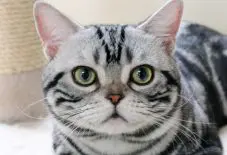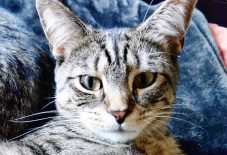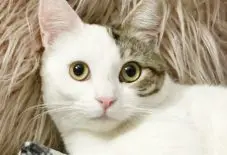
Meet the American Shorthair
Prrrfect Playmate
Chillest Cat
High Kitty I.Q.
If you’re looking for an easygoing family cat who is just as happy chilling out as playing around, I’m the breed for you! We American Shorthairs are known for being very adaptable and independent, so if you can’t hang at home with me all the time, it’s all good. Just make sure I have some fun toys to occupy myself and a window where I can observe the world around me – my ancestors were working mouse hunters, so I really enjoy watching birds and squirrels outside (even if I can’t go after them!). When my humans are home, I love to play indoors so I can get the exercise I need (I’ll get chunky if you don’t watch my weight).
I’m very mellow, so I’m great with kids and other cat-friendly animals. I may not be affectionate all the time, but that doesn’t mean I don’t love my humans – sometimes I just like to do my own thing. But don’t worry, when I do want some snuggles, you’ll know it! In keeping with my super low-maintenance vibe, I don’t shed a ton or need a lot of grooming to keep myself looking furbulous – weekly brushings are enough for me. Because I’m such a good-natured sweetie, I’m a sweet choice for a first-time cat parent, which is just one of the many reasons I’m one of the most popular cat breeds!
Ready to learn more about me? Let’s dig in.
Ready to learn more about me? Let’s dig in.
 My Many Looks
My Many Looks

Brown Tabby

Silver Tabby

Calico

Tuxedo
 My Breed Characteristics
My Breed Characteristics
 Furbulous Fact
Furbulous Fact
Even though I am an all-American breed, I wasn’t always called the American Shorthair. My breed used to be called the Domestic Shorthair up until 1966, when we were re-named “American,” which the humans thought was more patriotic. Today, Domestic Shorthairs exist, but they are not purebred like me. Many humans confuse the two of us because we can look very similar, but we American Shorthairs are pedigreed cats and Domestic Shorthairs are not. To keep us up to the breed standard, American Shorthair breeding programs were created to distinguish us from other non-pedigreed shorthaired cats.
 As I Grow Up
As I Grow Up
As you can see, we American Shorthairs age pretty gracefully. Here are a few key milestones in my growth & development to be aware of as I grow up from a kitten to an adult and senior!

Kitten3 Mo-2 Yrs
Since my breed is prone to obesity, It’s impawtant I get proper nutrition, food portions, and daily exercise from the very start.

Adult3-4 Years
I’m one of the healthiest breeds around. Help keep it that way by staying on top of my weight, dental care, and yearly vet check-ups!

Senior10 Years
I’m not the most active breed, so as I age – pawlease make sure I get enough exercise and adjust my diet if needed to stay fit!
 History of My Breed
History of My Breed
We American Shorthairs are older than the United States of America itself! My early ancestors were European working cats who were excellent hunters and took care of rodent problems on ships, keeping their humans free from the diseases that those animals could carry. We came to North America on the Mayflower and landed in Plymouth, MA in 1620 with the early colonists from Europe. Some humans think we may have even been on earlier ships with colonists who landed in Jamestown, VA in 1607, with the Spanish who landed in Florida, or even the Vikings who landed in Newfoundland! Once my ancestors reached the New World, they worked as mousers in Colonial America and were prized for their hardiness and hard work. As settlement of America expanded, we went along with our human pioneers – after all, there were always vermin for us to catch back then!
We were always popular in America, and in 1895 we were exhibited at America’s first major cat show at Madison Square Garden in New York City. Back then we were still called the Domestic Shorthair (and would be until the 1960s), but our popularity across the nation made us one of the first five breeds recognized by the Cat Fanciers’ Association in 1906. At around this time, Americans started to fancy more exotic imported cat breeds like Persians and Angoras, but the American Shorthair lovers were devoted to us and began a selective breeding program to keep us going strong. Still, American tastes caused some breeders in the late 1950s to crossbreed us with Persians.
When we were officially named the American Shorthair in 1965, the breed standard excluded these hybrids. That year, a silver tabby American Shorthair named Shawnee Trademark won CFA’s Best Cat, solidifying our place among the world’s top breeds. Today, we are the #6 most popular cat breed!
 Pawesome Cats to Parent
Pawesome Cats to Parent
In addition to purebred American Shorthairs like me, there are tons of prrrfectly sweet mixed-breed American Shorthairs that are looking to find their furever homes. You can learn where to find your next pet below!
 Care Tips
from Dr. Sarah Wooten, Veterinarian
Care Tips
from Dr. Sarah Wooten, Veterinarian 
Get key health screenings and routine wellness care.
In addition to yearly wellness exams, recommended vaccines for your cat’s lifestyle, routine blood, urine, and fecal screens, and appropriate parasite prevention, talk to your vet about getting a DNA test + other health screenings for hereditary conditions and breed-specific health issues. HCM, which is short for a heart disease called Hypertrophic Cardiomyopathy, has been confirmed as an autosomal dominant inherited trait in American Shorthair cats. While there isn’t a specific genetic test for this disease, it’s important to confirm that the parents of any American Shorthair kitten you are purchasing have been tested and shown to be free of the disease via imaging studies, such as an echocardiogram and radiographs.
Feed the right amount of a high quality diet.
While American Shorthair cats do not have any special dietary requirements when compared to other cats, they are at risk of developing obesity. Choose a high-quality cat food that is certified to be complete and balanced by AAFCO, and feed a combination of wet and dry food. Equally as important is to not overfeed American Shorthair cats because obesity can predispose them to a large number of chronic diseases. You can use the hand test to determine if your cat is at a healthy weight, or ask your vet what is a good weight for your cat.
Tips for a well-behaved American Shorthair.
American Shorthair cats are laid back, social, and intelligent cats that are easy to care for. However, be aware that they do like to play, and if they are bored or stressed, American Shorthairs can be destructive or develop stress-related health disorders, so make sure to have plenty of entertaining things for your cat to do. American Shorthairs enjoy moderate exercise, so provide lots of room for your cat to run in your home, along with vertical space for climbing, vertical and horizontal scratching surfaces, and daily playtime sessions. Understand that when a cat misbehaves, they are saying they need something from you, and work with a vet or certified behaviorist if you run into problems with your cat.

 Why Get Cat Insurance?
from Pumpkin®
Why Get Cat Insurance?
from Pumpkin®
While American Shorthairs are a generally healthy breed, cat-astrophes can happen to any cat at any age. If your kitty gets hurt or sick, pet insurance can help you say ‘yes’ to the best care, even when it’s costly. When it comes to shopping for this breed, you’ll want to choose an insurance plan like Pumpkin plan that covers hereditary conditions American Shorthairs are prone to developing, and that can be costly to treat. While a reputable breeder will conduct genetic testing on your kitty’s parents to help minimize the chances of passing down hereditary conditions – they can’t always be avoided. Let’s look at some common ones, and how Pumpkin Cat Insurance plans could help cover the cost of care!
 Obesity
Obesity
American Shorthairs are not the most active breed – putting them at a higher risk for obesity. Overweight cats are more likely to develop other health issues, like diabetes, arthritis, and heart disease. That said, obesity is easily treatable with dietary changes, meds, and increased exercise.
- Cost to Treat
- $200-$2,000
- Pumpkin Pays Back*
- $180-$1,800
 Periodontal Disease
Periodontal Disease
This breed is prone to periodontal (gum) disease, which occurs when plaque builds up and forms a layer of tartar that inflames the gums. Left untreated, gums weaken and separate from teeth. While routine brushing, cleanings, and antibiotic gels help treat milder cases, severe ones require surgery.
- Cost to Treat
- $400-$1,200
- Pumpkin Pays Back*
- $360-$1,080
 Heart Disease
Heart Disease
Like many cat breeds, American Shorthairs can develop heart disease, specifically Hypertrophic Cardiomyopathy (HCM). This condition causes the muscle walls of the heart to thicken, leading to a decline in cardiac function. While there’s no cure, HCM can be managed with meds and dietary changes.
- Cost to Treat
- $500-$3,000
- Pumpkin Pays Back*
- $450-$2,700
 Hip Dysplasia
Hip Dysplasia
Some American Shorthairs develop hip dysplasia. This occurs when the hip joint’s ball and socket doesn’t develop or work properly, causing joint deterioration, pain, lameness, and/or arthritis. While mild cases are treated with prescription meds and physical therapy, severe ones require surgery.
- Cost to Treat
- $200-$2,500
- Pumpkin Pays Back*
- $180-$2,250
*Sample shows 90% reimbursement of covered vet bill assuming $250 annual deductible has been met.




